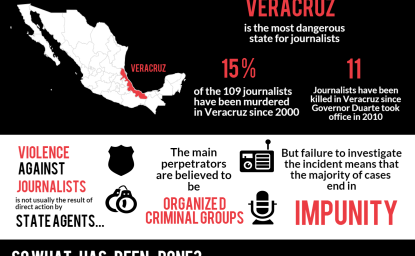Violence against Journalists in Mexico
According to the Committee to Protect Journalists (CPJ), Mexico is among the world’s most dangerous countries for journalists. In this Expert Take, Eric L. Olson expands on this phenomenon.
According to the Committee to Protect Journalists (CPJ), Mexico is among the world’s most dangerous countries for journalists. In this Expert Take, Eric L. Olson expands on this phenomenon.

The tragic news this week that another Mexican journalist has fallen victim to violence is not just disturbing, but profoundly troubling. The victim, a freelance journalist named Anabel Flores Salazar, was a crime reporter for the daily Sol de Orizaba in the eastern state of Veracruz. She was a mother of two and according to a family member, had given birth just two weeks before her abduction and subsequent death.
According to family members, a group of armed men dressed in military-style uniforms with covered faces arrived at the house in a state police truck. They said they had a warrant to conduct a routine search. Then they entered the home, searched for Flores, and abducted her. When the family appealed to authorities, they were told there was no record of her detention.
The Flores case is tragic, but it’s not isolated. Her death is indicative of a much larger problem: the continued targeting of journalists by criminal groups and the decidedly apathetic response of Mexican authorities.
According to the Committee to Protect Journalists (CPJ), Mexico is among the world’s most dangerous countries for journalists. CPJ reports that 10 journalists have been killed in Mexico since 2010. According to Mexico’s National Human Rights Commission, Veracruz is the country’s most dangerous state for journalists, accounting for nearly 15 percent of the 109 journalists who have been murdered since 2000. Just two weeks before Flores was murdered, another local journalist was murdered in the state of Oaxaca.
Violence against journalists is not usually the result of direct action by state agents. In many instances organized criminal groups are believed to be the main perpetrators. In some instances, criminal networks have aggressive communications strategies planting stories with local media outlets or insisting that unfavorable coverage be removed. There are often violent consequences when press doesn’t follow their dictates.
Even when the state is not directly responsible for the violence, failure to fully investigate the incident means that the vast majority of cases end in impunity. According to the CPJ’s senior program coordinator for the Americas, Carlos Loria, "The administration of [Veracruz] Governor Javier Duarte Ochoa has a dismal record of impunity and has been incapable and unwilling to prosecute crimes against the press."
Violence against journalists is not a recent phenomenon in Mexico, though efforts to tackle impunity are relatively new, tracing back to the previous government of Felipe Calderón. In response to the public and international outcry, President Calderón announced the formation of a special prosecutor’s office to deal specifically with these cases. I met with the first two special prosecutors who assured me they were reviewing all the cases and giving the matter the highest possible priority, but very little happened. Many cases were opened, some gathering of evidence took place, but very few cases where actually brought before a judge and only one resulted in a sentence. It is shameful.
A common response from state and federal judicial authorities to violence against journalists is to either blame the victim for ties to criminals or to allege that the crime had nothing to do with the journalist’s profession but rather with a personal conflict, often an amorous affair. In the Flores case, the Veracruz state prosecutor is reported to have gone on the air after Flores’s body was discovered to suggest that she had a “sentimental” relationship with a criminal element that possibly resulted in her death. Leaving such an explosive allegation in the public sphere with no attempt to clarify the details or prosecute the responsible leaves the sense that no one really cares about the death of a journalist, and that their role is not valued. This impression alone has a profound impact on journalists and their ability to carry out their work. Ultimately, this indifference toward the death of journalists undermines the public‘s right to information and weakens democracy.
Another way for federal authorities to avoid responsibility in these cases has been to argue that the murders of journalists are of local, not federal, jurisdiction. But this technicality was supposedly resolved by the federalization of crimes against journalists in 2013. Nevertheless, it remains an imperfect solution since federal authorities still have to follow a procedure to transfer the case from local to federal jurisdiction and there are too many ways this process can be delayed (even indefinitely), resulting in further inaction.
It is also worth noting that while the primary responsibility for state action rests with judicial authorities, the media itself has been largely silent on the issue. The vast majority of cases involve journalists working for local news outlets. These are often far from the limelight of the big cities like Mexico City, Monterrey, and Guadalajara. Like Flores, these victims often work for newspapers in small cities, and for media outlets often dependent on advertising revenue from local government. It is not uncommon for the major media ownership groups to view violence against journalists as a local problem not affecting them directly; with local owners enormously vulnerable to the political machines and criminal bosses that run the local jurisdiction. In effect, threats against local journalists are often seen as someone else’s problem that doesn’t warrant much attention from the media conglomerates.
So what can be done? Fundamentally, it will require Mexicans of all stripes to see violence against journalists as a national tragedy that undermines the country’s democracy. As long as it remains someone else’s problem, as long as it can be explained away as the result of a personal conflict or a lover’s quarrel, violence against journalists will continue unabated. The criminal bosses, political and judicial authorities, and media industry will continue to operate as if nothing is really at stake, though nothing could be further from the truth.
During the worst of Colombia’s violence, newspaper publishers banded together to protect one another, sometimes publishing the exact same story on their front pages as a way of saying, if you attack one of us you attack all of us. Mexico’s media ownership, both national and local, needs to display the same spirit of solidarity during this dark time.
It’s also vitally important for Mexico’s political leadership at the highest levels to see these cases not as individual cases to be managed, but as a symptom of much bigger problems in society: corruption and a state that is unable to end impunity. Special laws and prosecutors are no longer lacking, but the political will to make this tragedy a national priority are in short supply.


The Mexico Institute seeks to improve understanding, communication, and cooperation between Mexico and the United States by promoting original research, encouraging public discussion, and proposing policy options for enhancing the bilateral relationship. A binational Advisory Board, chaired by Luis Téllez and Earl Anthony Wayne, oversees the work of the Mexico Institute. Read more



